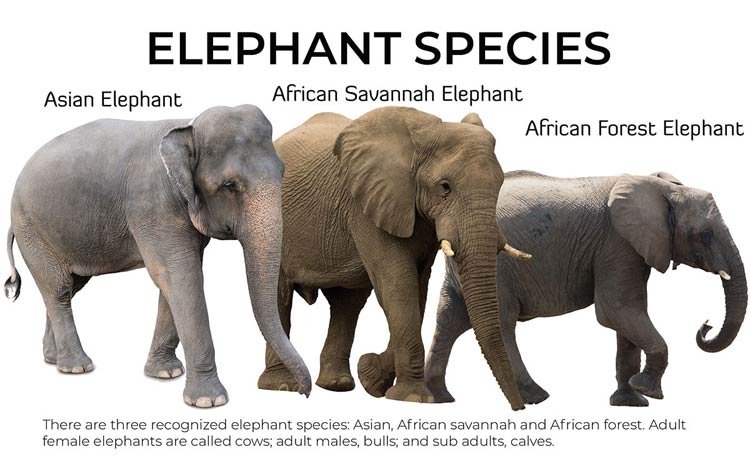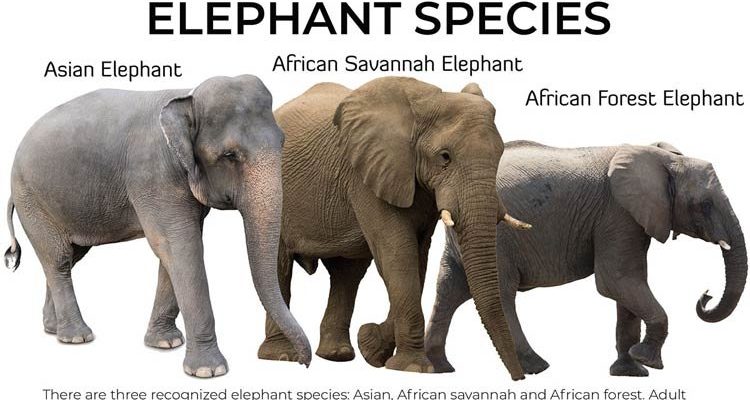
In this article, we’ll take a look at ten animals similar to the African Forest Elephant. You might be surprised by how closely related some of these species are or how they share certain characteristics, like size, habitat, or behavior. Let’s dive in and explore these remarkable animals, noting their differences and how to tell them apart.
1. African Savanna Elephant
The African Savanna Elephant is perhaps the most famous relative of the African Forest Elephant. These elephants are larger and more widely recognized, often found roaming the open grasslands and savannas.
Size and Habitat: The Savanna Elephant is generally taller, with males reaching heights of up to 13 feet. They tend to live in herds and can be found in various African regions, from grasslands to deserts. On the other hand, the Forest Elephant is smaller and prefers dense forests.
Physical Differences: You can spot the Savanna Elephant by its larger ears, which are shaped like Africa on a map, helping to dissipate heat. Their tusks are longer and more curved compared to the shorter tusks of the Forest Elephant.
2. Asian Elephant
Moving on to Asia, we encounter the Asian Elephant, which shares some similarities with its African cousins but also has distinct traits.
Size and Build: Asian Elephants are generally smaller than their African counterparts, standing around 10 feet tall. They have a more rounded back and smaller ears.
Behavioral Traits: Unlike the more social Savanna Elephants, Asian Elephants are often seen alone or in smaller family units. They also have a unique trait: a single “finger” on the tip of their trunk, which allows them to grasp things more precisely.
3. Borneo Pygmy Elephant
This tiny elephant is a population of Asian Elephant found in Borneo; it’s the smallest subspecies of Asian Elephants. Imagine a baby elephant that’s all grown up—this is what the Borneo Pygmy Elephant looks like.
Physical Characteristics: They stand around 8 to 10 feet tall and have a more delicate, youthful appearance. Also, their tusks are smaller and often absent in females.
Habitat Distinction: These elephants prefer the lush rainforests of Borneo. Their smaller size helps them navigate through these dense habitats more easily than their larger relatives.
4. Mammoths
Though long extinct, mammoths are among the closest relatives to modern elephants, making them fascinating to compare.
Comparison in Size: Mammoths were comparable in size to the African Savanna Elephant but had distinctive long, curved tusks—ideal for digging through snow for food.
Adaptations: They were perfectly adapted to cold environments, with a thick layer of fur and a hump of fat to insulate them against the cold. In contrast, Forest and Savanna Elephants have shorter hair and are more suited to warmer climates.
5. Woolly Rhinoceros
While it might seem surprising, the woolly rhinoceros shares a primal connection to the elephant family.
Physical Traits: Woolly rhinos were similar in size to the mammoth but had a heavier build and two distinct horns on their snouts. Unlike elephants, these rhinos had thick fur to protect them from cold climates.
Habitat and Diet: They roamed the grasslands of Europe and Asia during the last Ice Age, feeding mostly on tough, fibrous plants.
6. Tapirs
Tapirs may look cute and a bit awkward, but they share a more distant connection to elephants.
Size Comparison: Tapirs are much smaller, weighing around 600 pounds and standing about 3 feet tall. They have a distinctive body shape, with a rounded body and short legs that make them look a bit like giant piglets.
Natural Habitat: These creatures are found in Central and South America, preferring forests and grasslands where they can graze on leaves, fruits, and aquatic plants.
7. Manatees
Another surprising cousin is the manatee. Often dubbed “sea cows,” these gentle marine mammals share certain genetic ties with elephants.
Similarities in Behavior: Like elephants, manatees are herbivores and have a slow, peaceful demeanor. They are social creatures and often move in groups.
Differences in Environment: While elephants thrive on land, manatees inhabit warm, shallow waters. Their round bodies and paddle-like tails give them a unique look that sets them apart from any elephant!
8. Hyrax
You might not expect the hyrax to be related to elephants, but they are surprisingly close cousins in the mammal world!
Physical Appearance: Hyraxes are small, about the size of a domestic cat, with rounded bodies and short legs. They have a distinctive rodent-like appearance but are more closely related to elephants than to rodents.
Behavioral Traits: These social animals live in groups and are often found in rocky areas where they can hide from predators, similar to how elephants protect their young from threats.
9. Giant Ground Sloth
Long gone but still intriguing, the Giant Ground Sloth was a huge creature that roamed South America during the Ice Age.
Size Comparison: These sloths could weigh over 1,000 pounds and stand over 10 feet tall when upright, making them comparable in size to elephants.
Dietary Preferences: They were herbivores, feasting on leaves and plants, much like elephants do today—though with a much slower approach!
10. Hippopotamus
Finally, we reach the hippopotamus. While they look quite different, hippos share some surprising traits with elephants.
Similarities in Size: Hippos can weigh as much as 4,000 pounds and are known for their massive bodies.
Habitat Differences: Unlike elephants, which live on land, hippos spend most of their time in water, grazing on grasses at night. They also have a strong social structure, forming groups called pods, similar to elephant herds.
In summary, the African Forest Elephant has many relatives that share some of its traits, whether in size, habitat, or behavior. From the larger Savanna Elephant to the quirky tapir, these animals highlight the amazing diversity of the animal kingdom. Understanding these similarities and differences helps us appreciate wildlife and the need for conservation efforts to protect these unique creatures.
So, the next time you hear about elephants, remember: they’re not just a solitary species but part of a fascinating family that spans continents and habitats. Whether it’s the mighty mammoth or the gentle manatee, these animals show us how interconnected life on Earth really is.

